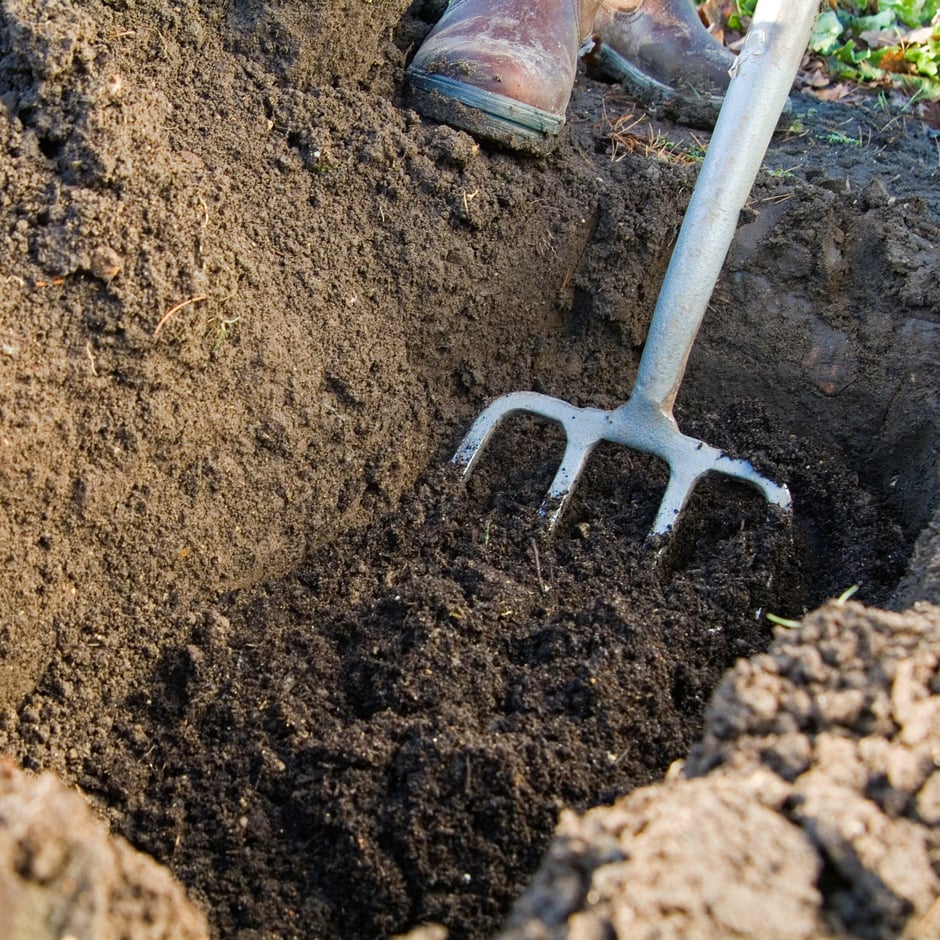Double digging
Double digging is a traditional method used to prepare ground for planting. It involves digging the soil to twice the depth of a spade. Most people do not need to double dig their garden soil. Single digging, no-dig methods, or preferably not digging are better options

Quick facts
Timing Late winter and early spring
Difficulty Moderate-hard
Jump to
What is double digging?
Double digging is a labour-intensive way of cultivating soil, digging not just to one spade’s depth (known as single digging) but to two. Hence, the term ‘double digging’.
For many years, it was the standard technique to prepare uncultivated soil for planting.
Why double dig?
Double digging can occasionally be useful when creating new beds and borders for these reasons:
- To reduce soil compaction that occurs below normal digging depth (25cm/10ins)
- To mix in organic matter, such as garden compost or manure, for deep rooted plants such as asparagus
- To remedy poor drainage
- To open up soil structure at depth for deep rooted vegetable crops and long-term ornamental plantings
Do I need to double dig?
Most people choose not to double dig their soil, and evidence for its effectiveness is limited to the circumstances mentioned above. You may see it mentioned in older gardening books, but it is physically demanding work and slow progress.
Additionally, single digging, no-dig methods or avoiding digging altogether by growing plants on bare soil (crops or green manures) usually provide similar or equal benefits. For this reason, double digging is rarely practiced or necessary these days.
Where possible, limit soil disturbance to a minimum. This means not digging, forking or rotovating (tilling) soil. Doing this is proven to enhance fungal networks and nurture soil-dwelling fauna that in return improve the structure of soil. Good soil structure is important for nutrient availability, overall plant health and drainage. Think of your soil as a balanced ecosystem, easily disrupted by cultivation.
When to double dig
If other methods, such as single digging or no-dig gardening, have proven ineffective in resolving soil compaction and drainage issues, double digging may be effective.
The first thing to work out is whether the soil is truly compacted. These conditions are most likely to occur where heavy machinery has been used, for instance around new build homes. Compaction issues are typically indicated by slow draining puddles of water following rain.
To test your soil for compaction and drainage issues:
- Dig a hole around 50cm deep and a spade’s width, removing all the soil.
- Place the subsoil and topsoil (darker in colour) in separate piles.
- Examine the sides of the pit for compaction – layers of dense, hardened soil that roots can’t penetrate.
- Fill the pit to the top with water and leave overnight, covered against rain.
- See how much water remains in the pit the following day. If half, or over half, of the water remains, then drainage is an issue.
- Once drained (or bailed out), refill the hole, starting with subsoil.
Where compaction and drainage issues occur in the top 25cm of soil, single digging, or forking over, will usually suffice to remedy this. Alternatively, sow deep-rooted plants such as lucerne (alfalfa), sunflowers (Helianthus) or mooli radish. The roots of these plants are often effective in breaking through layers of shallow compaction.
If soil is poorly draining at a deeper level, i.e. below 25cm, it may benefit from double digging.
How to double dig
If you do decide your soil would benefit from double digging, follow these steps:
- First, dig a trench with a spade along the one side of a bed. The soil from this trench is set aside.
- Fork over the base of the trench using a garden fork. Ideally, incorporate organic matter such as garden compost at this stage – use about a bucketful per square metre.
- Dig the next trench. Take a step backwards, creating a gap between your feet and the first trench – in this gap, dig your next trench alongside the first (parallel). The soil dug from this second trench is turned into the first trench (filling it back up).
- Repeat step 3 until the whole area is dug.
- When you reach the end, the soil set aside from the first trench is used to fill the last.
After digging
If you’re unable to plant crops straight away, sow green manures or mulch the surface. This is better than leaving soil exposed to the elements.
Although soil re-compacts over time, it’s not necessary to regularly double dig, even on heavy soils. Digging once is usually sufficient to alleviate deeper level compaction, unless heavy machinery is used again in the area.
To improve soil fertility, there is no need to dig in organic matter – just apply a surface mulch of garden compost or manure annually in late winter or early spring. This will be incorporated by soil organisms.
Get involved
The Royal Horticultural Society is the UK’s leading gardening charity. We aim to enrich everyone’s life through plants, and make the UK a greener and more beautiful place.